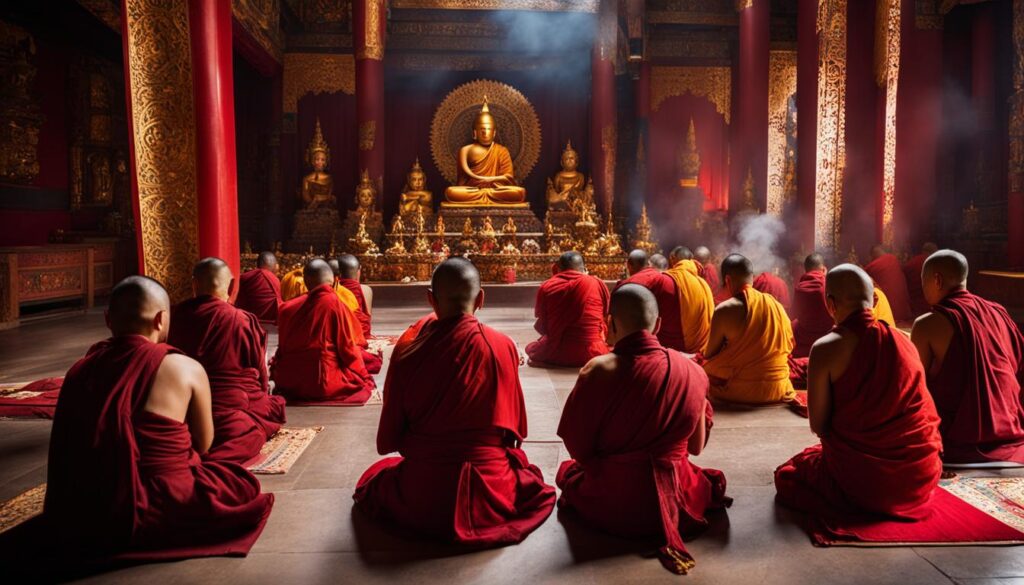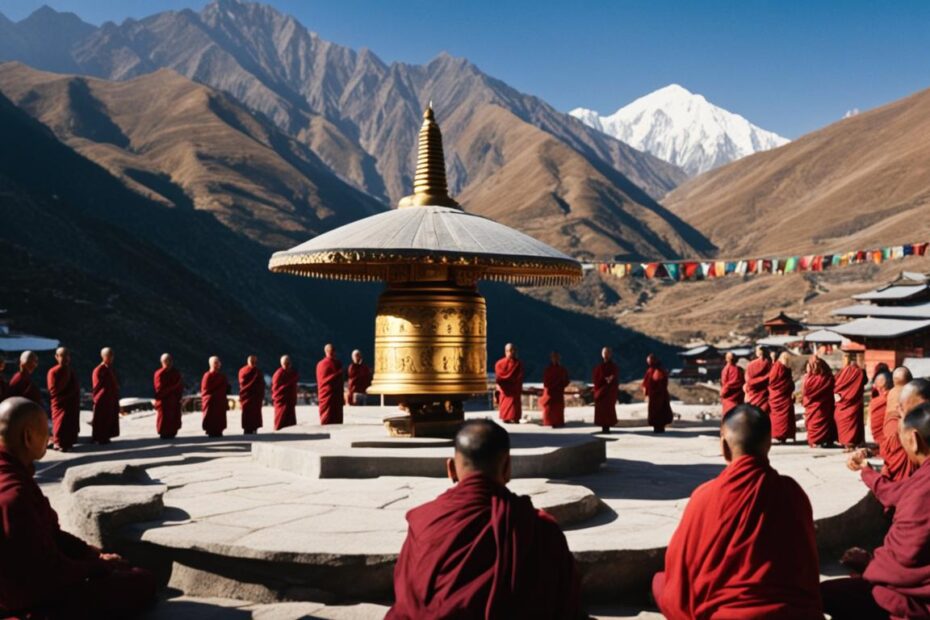Buddhism is a profound path of transformation that goes beyond mere intellectual understanding. It is a journey that engages the heart, mind, and spirit, allowing individuals to connect deeply with the teachings and ideals of Buddhism. One of the ways in which this connection is fostered is through the practice of Buddhist prayer traditions and rituals.
Through recitation, chanting, and the making of offerings, Buddhist practitioners create a sacred space for their spiritual aspirations to take form. Recitation involves the repetition of verses that express their deepest aspirations, allowing the words to permeate their being and guide their thoughts and actions. Chanting, often done in ancient languages such as Pali or Sanskrit, creates a melodic rhythm that resonates with the core teachings of Buddhism, fostering a deeper emotional connection with those ideals. The act of making offerings, whether it be flowers, candles, or incense, is a symbolic gesture that represents impermanence, enlightenment, and the commitment to ethical living.
Key Takeaways:
- Buddhist prayer traditions and rituals provide a direct emotional connection with the teachings and ideals of Buddhism.
- Recitation of sacred verses allows practitioners to express their spiritual aspirations and guide their thoughts and actions.
- Chanting in ancient languages creates a profound emotional resonance with the core teachings of Buddhism.
- Making offerings symbolizes impermanence, enlightenment, and a commitment to ethical living.
- Engaging in Buddhist prayer traditions and rituals deepens the connection to the spiritual domain and cultivates positive qualities such as compassion and wisdom.
The Three Primary Buddhist Traditions
When exploring the world of Buddhism, it is essential to understand the three main traditions that have shaped the religion over centuries: Mahāyāna, Theravāda, and Tibetan Buddhism. Each tradition offers unique practices and perspectives on meditation, chanting, and devotional rituals.
Mahāyāna Buddhism
Originating in Northeast Asia, Mahāyāna Buddhism places a strong emphasis on meditation as a means of attaining wisdom and enlightenment. This tradition recognizes the role of not only monastic practitioners but also laypeople in their spiritual journey. In Mahāyāna Buddhism, meditation techniques, chanting practices, and devotional rituals are commonly incorporated to deepen one’s spiritual practice and foster a connection with Buddhist ideals.
Theravāda Buddhism
Theravāda Buddhism, prevalent in Southeast Asia, centers its spiritual practice primarily around meditation. Through the practice of meditation, followers of Theravāda aim to achieve enlightenment and liberate themselves from the cycle of rebirth. By focusing on mindfulness and concentration, individuals cultivate insight into the impermanent nature of reality and develop a deeper understanding of themselves and the world around them.
Tibetan Buddhism
Tibetan Buddhism is renowned for its rich rituals, prayers, and visual aids that facilitate spiritual growth and deepen one’s connection with the divine. Chanting, mantras, and yogic techniques are integral to Tibetan Buddhist practice. These devotional practices, combined with meditation, create a profound and transformative spiritual experience. Tibetan Buddhism places great emphasis on the power of sound, visualization, and sacred symbols to transcend ordinary consciousness and achieve profound states of awareness.
By exploring the three primary Buddhist traditions – Mahāyāna, Theravāda, and Tibetan Buddhism – practitioners can discover the diverse ways in which meditation techniques, chanting practices, and devotional rituals contribute to the spiritual journey.
Tibetan Buddhist Rituals
Tibetan Buddhism is renowned for its rich and intricate rituals, which serve as powerful means of spiritual practice and connection with the divine realm. These rituals encompass a diverse range of practices, including the recitation of sacred scriptures, the use of mantras, yogic techniques, and the incorporation of visual aids to deepen understanding and foster a profound spiritual experience.

Within Tibetan temples and monasteries, ceremonies are meticulously planned to create a visually captivating and immersive environment. During these rituals, formally dressed monks recite ancient scriptures, chant sacred mantras, and employ various musical instruments such as brass instruments, cymbals, and gongs. These melodic sounds, combined with the rhythmic chanting, create an ambiance that transports practitioners into a heightened state of spiritual awareness.
These rituals hold deep significance for Tibetan Buddhists, as they believe that the recitation of sacred scriptures and the repetition of mantras not only accumulate spiritual merit but also enhance their spiritual growth and well-being. Moreover, the intricate movements and visual symbols used in these rituals aid in transcending the limitations of ordinary consciousness, allowing them to establish a profound connection with the divine.
“Through the practice of Tibetan Buddhist rituals, we are able to tap into the vast reservoir of wisdom and compassion that resides within us. It is through these sacred practices that we can deepen our understanding of the teachings and manifest the transformative powers of prayer.”
The Benefits of Buddhist Prayer
The practice of Buddhist prayer holds immense benefits for practitioners on their spiritual journey. When individuals engage in prayer, they cultivate qualities such as mindfulness, compassion, and wisdom, which serve as the building blocks of spiritual growth and liberation.
Additionally, the act of reciting sacred scriptures and chanting mantras has a calming effect on the mind and body, promoting inner peace and serenity. Through these practices, individuals can experience a deep sense of connection with the divine and find solace in the teachings of Buddha.
| Benefits of Buddhist Prayer | Explanation |
|---|---|
| Merit Accumulation | Buddhist prayer is believed to accumulate spiritual merit, which brings positive outcomes and paves the way for future enlightenment. |
| Spiritual Growth | Engaging in Buddhist prayer helps individuals cultivate qualities such as compassion, wisdom, and mindfulness, leading to profound spiritual growth. |
| Control over Bodily Functions | Tibetan Buddhists believe that through the power of prayer, one can gain control over bodily functions and achieve a greater harmony between mind and body. |
By immersing themselves in the profound rituals of Tibetan Buddhism and embracing the transformative power of Buddhist prayer, practitioners can unlock the abundant blessings that these ancient practices offer, leading to a path of spiritual enlightenment and inner fulfillment.
Tibetan Buddhist Offerings
Tibetan Buddhists incorporate various offerings as a way to express devotion and accumulate merit in their spiritual practice. These offerings serve to honor the Buddhas and bodhisattvas, while also creating a profound connection between the physical and spiritual realms.
Some of the traditional offerings made by Tibetan Buddhists include:
- Flowers
- Food
- Small banknotes
- Barley grains
- Draping white and yellow gauze strips around statues
Additionally, Tibetan Buddhists engage in practices such as lighting butter lamps, turning prayer wheels, and leaving swaths of sheep wool for a good harvest.
These offerings are symbolic gestures of respect and devotion, representing the impermanence of life and the aspiration for enlightenment. They are believed to bring blessings and cultivate positive qualities in the practitioner’s life.

Symbolic Tibetan Buddhist Offerings
| Offering | Symbolism |
|---|---|
| Flowers | Represent impermanence and the transient nature of life |
| Food | Symbolize generosity and the act of offering nourishment to the spiritual realm |
| Small banknotes | Signify wealth and the offering of prosperity to the Buddhas and bodhisattvas |
| Barley grains | Represent abundance and the offering of sustenance to spiritual beings |
| Gauze strips | Symbolize purity and are draped around statues as a mark of respect |
By engaging in these sacred rituals of offering, Tibetan Buddhists cultivate a sense of reverence and deepen their connection to the spiritual dimensions of life.
Tibetan Buddhist Customs
Tibetan Buddhists have rich customs that infuse their spiritual practices with a sense of reverence and devotion. These customs not only create a sacred atmosphere but also serve as a way to demonstrate respect for sacred sites and objects. By engaging in these customs, practitioners deepen their spiritual connection and embody the teachings of Buddhism in their daily lives.
Walking Circumambulation
A common custom in Tibetan Buddhist traditions is walking circumambulation around sacred sites such as stupas, temples, and sacred mountains. This practice involves moving in a clockwise direction while reciting sacred prayers or mantras. This act of walking in a circular path symbolizes the continuous cycle of life and represents the progress towards enlightenment. It is believed that through circumambulation, individuals accumulate merit and purify negative karma.
Prostration and Forehead Tapping
During pilgrimages or visits to monasteries, Tibetan Buddhists often engage in prostration as a sign of respect and devotion. Prostration involves kneeling down and touching the ground with one’s forehead, hands, and knees. This physical act of surrendering to the spiritual path represents humility, gratitude, and the aspiration for enlightenment. Additionally, pilgrims may tap their foreheads to silk scarves hanging inside chapels, symbolizing their reverence for the teachings and blessings of the Buddha.
Greeting with White Scarves
The exchange of white scarves, called hada or khatang, is a significant custom in Tibetan Buddhist culture. When meeting a revered teacher or visiting a sacred place, offering a white scarf is a traditional way to show respect and express good wishes. The exchange of these scarves symbolizes the sharing of positive intentions, blessings, and well-being. It is a beautiful expression of gratitude and reverence towards others on the spiritual path.
Etiquette and Respectful Conduct
Respecting the customs and traditions of Tibetan Buddhism is essential when engaging in practices or visiting sacred spaces. It is customary to remove shoes before entering monasteries or temples as a sign of respect and to maintain cleanliness in the sacred environment. Taking photographs during prayers or meditation is generally discouraged to ensure a conducive atmosphere for contemplation and focus. By adhering to proper etiquette, individuals demonstrate their deep respect for the profound teachings and the community of practitioners.

Through these customs, Tibetan Buddhists create a spiritual atmosphere that enriches their practice and deepens their connection with the teachings. These rituals and gestures of respect reflect the devotion and sincerity of the practitioners, fostering a sense of unity and reverence within the Tibetan Buddhist community.
Tibetan Buddhist Prayers
Prayer is a profound and integral aspect of Tibetan Buddhist practice. Tibetan Buddhists engage in prayers throughout the day, using various methods to honor Buddha and accumulate merit. These prayers serve as a powerful means of cultivating compassion, focusing the mind, and deepening spiritual connection with the divine.

The act of prayer is seen as an essential pathway to enlightenment and the embodiment of Buddhist values. Tibetan Buddhists employ a range of practices to express their devotion and seek spiritual blessings. Some common practices include:
- Lighting yak butter lamps: This act symbolizes illumination, wisdom, and dispelling darkness.
- Burning incense: The fragrant scent serves as an offering to the deities and purifies the environment.
- Tying prayer flags: Prayer flags are inscribed with sacred mantras and prayers, and their fluttering in the wind is believed to spread positive energy and blessings.
- Repeating chants: Chanting mantras and prayers repeatedly helps to cultivate focus and transform the mind.
- Making mani stones: Stones inscribed with sacred mantras are created as symbols of devotion and placed in sacred locations or used during meditation.
- Spinning prayer wheels: These cylindrical devices, filled with mantras, are spun in a clockwise direction to send prayers and blessings into the world.
These practices are often performed in monasteries and at sacred sites, where the atmosphere is charged with devotion and spiritual energy. Morning prayers within monasteries may involve the lighting of candles and the sounding of horns, creating an awe-inspiring ambiance and invoking a sense of reverence.
“Prayer is not just an act, but a sacred connection to the divine, a way to express deep gratitude, and a path to inner transformation.” – Lama Tenzin
Through Tibetan Buddhist prayers, individuals seek to purify their minds, develop compassion, and attain higher states of consciousness. Prayer offers a means of centering oneself, cultivating mindfulness, and finding solace in the challenges of life. Moreover, it is a way to connect with the broader Buddhist community and contribute positive intentions and aspirations for the benefit of all beings.
Meditation Techniques in Tibetan Buddhism
Meditation is deeply intertwined with Tibetan Buddhist prayer practices. It serves as a complementary practice to prayer, enabling individuals to cultivate inner stillness, develop insight, and expand their spiritual awareness. Tibetan meditation techniques focus on the following:
- Breath awareness: Paying attention to the breath helps to calm the mind and cultivate present-moment awareness.
- Visualizations: Practitioners visualize deities, sacred symbols, and divine realms to deepen their connection with spiritual qualities and states of consciousness.
- Metta meditation: Metta, or loving-kindness, meditation involves generating feelings of compassion, love, and well-wishing for oneself and all sentient beings.
- Tonglen meditation: In this practice, practitioners cultivate compassion by visualizing themselves taking in others’ suffering and sending out love, compassion, and healing energy.
- Analytical meditation: This technique involves contemplation and analysis of specific teachings or philosophical concepts, with the aim of gaining deeper insights into their meaning.
In Tibetan Buddhism, the integration of prayer and meditation creates a holistic spiritual practice that combines devotion and introspection. Both prayer and meditation serve as powerful tools for deepening one’s spiritual connection and transforming the mind.
| Tibetan Buddhist Prayers | Meditation Techniques |
|---|---|
| Lighting yak butter lamps | Breath awareness |
| Burning incense | Visualizations |
| Tying prayer flags | Metta meditation |
| Repeating chants | Tonglen meditation |
| Making mani stones | Analytical meditation |
| Spinning prayer wheels |
Mahāyānan Buddhist Meditation Techniques
Mahāyānan Buddhists, particularly those in Northeast Asia, deeply value the practice of meditation as a powerful tool for achieving wisdom and enlightenment. Through dedicated meditation, practitioners aim to deepen their understanding of Buddhist teachings and cultivate greater insight into the nature of reality.
The specific techniques used in Mahāyānan Buddhist meditation vary, but they often involve several key elements. Focusing on the breath serves as a foundation for cultivating mindfulness, bringing awareness to the present moment and quieting the mind. Visualization techniques, such as imagining sacred figures or visualizing the qualities of enlightenment, enhance concentration and deepen the meditative experience.
Regular meditation practice yields numerous benefits for the mind, body, and spirit. By dedicating time to meditation, individuals can experience increased peace of mind, reduced stress levels, and improved overall well-being. Through deepening their practice, meditators develop greater clarity, concentration, and insight into the fundamental truths of existence.
“Meditation brings peace and clarity to our minds, allowing us to tap into our innate wisdom and compassion.” – Thich Nhat Hanh
Benefits of Mahāyānan Buddhist Meditation Techniques:
- Increased peace of mind and mental clarity
- Reduced stress and anxiety
- Heightened self-awareness and emotional well-being
- Improved concentration and focus
- Deepened understanding of Buddhist teachings
- Cultivation of wisdom and compassion
Comparison of Mahāyānan and Theravādan Meditation Techniques
| Meditation Techniques | Mahāyānan Buddhism | Theravādan Buddhism |
|---|---|---|
| Focusing Technique | Emphasis on breath and visualizations | Emphasis on breath and bodily sensations |
| Goal | Attaining wisdom and awakening | Attaining enlightenment and liberation |
| Approach | More diverse techniques, including visualization | Simplicity and direct mindfulness |
| Common Practices | Zen, Pure Land, and Nichiren traditions | Vipassana (insight) and Samatha (concentration) |
Theravādan Buddhist Meditation Techniques
In addition to the Mahāyāna and Tibetan traditions, Theravādan Buddhists, primarily found in Southeast Asia, also place a strong emphasis on meditation as a means of attaining enlightenment. The meditation techniques employed in Theravādan Buddhism focus on mindfulness and concentration, allowing practitioners to cultivate deep insight into the impermanent and interconnected nature of reality.
Theravādan Buddhists often engage in prolonged meditation sessions, sitting in stillness and observing their breath or bodily sensations. This practice of mindful awareness helps individuals develop greater mental clarity, increase their spiritual growth, and ultimately liberate themselves from suffering.
The Benefits of Theravādan Meditation
Meditation is a transformative practice that holds numerous benefits for those who engage in it regularly:
- Increased Awareness: By cultivating mindfulness through meditation, practitioners develop a heightened sense of self-awareness, becoming more attuned to their thoughts, emotions, and bodily sensations.
- Emotional Stability: Theravādan meditation techniques foster emotional stability, enabling individuals to navigate life’s challenges with greater resilience and equanimity.
- Deeper Understanding: Through the practice of meditation, Theravādan Buddhists attain a deeper understanding of the mind and body, gaining insight into the nature of suffering and the impermanence of existence.
Theravādan Buddhist meditation techniques offer a profound path to spiritual growth and self-realization. By quieting the mind and turning inward, individuals can unlock the transformative power of meditation in their lives.
| Meditation Techniques | Benefits |
|---|---|
| Mindfulness Meditation | Enhances self-awareness and cultivates present-moment focus |
| Concentration Meditation | Develops mental stability and enhances the ability to sustain attention |
| Vipassanā Meditation | Deepens insight into the nature of reality and liberates from suffering |
Conclusion
Buddhist prayer traditions and rituals hold immense importance and have a transformative impact on the spiritual practice of Buddhists worldwide. These practices provide a direct emotional connection with the teachings and ideals of Buddhism, allowing practitioners to cultivate positive qualities such as compassion and wisdom.
Recitation, chanting, and the act of making offerings serve as pathways for deepening one’s connection to the spiritual domain. Through these practices, individuals can experience inner peace, mindfulness, and overall well-being in their lives.
Buddhist prayers and rituals have the power to bring about profound transformation, guiding practitioners on their spiritual journey. By exploring the rich traditions of Buddhist prayer, individuals can tap into the serenity and depth that these practices offer, enhancing their spiritual growth and understanding of the world around them.
Embracing Buddhist prayer traditions allows individuals to cultivate a deep sense of spirituality and embark on a path of self-discovery and enlightenment. These practices offer solace, inspiration, and guidance, enabling individuals to navigate life’s challenges with compassion, resilience, and a greater understanding of the interconnectedness of all beings.
FAQ
What are some common Buddhist prayer traditions and rituals?
Buddhist prayer traditions and rituals commonly include recitation, chanting, and making offerings. These practices allow for a direct emotional connection with the teachings and ideals of Buddhism.
What are the three primary Buddhist traditions?
The three primary Buddhist traditions are Mahāyāna, Theravāda, and Tibetan Buddhism. Each tradition incorporates different meditation techniques, chanting practices, and devotional rituals.
What are some Tibetan Buddhist rituals?
Tibetan Buddhist rituals often involve the use of mantras, yogic techniques, and visual aids to deepen understanding and connection with the spiritual domain. Tibetan temples and monasteries create visually striking and immersive experiences during ceremonies.
What are Tibetan Buddhist offerings?
Tibetan Buddhists make offerings such as flowers, food, small banknotes, and draping gauze strips around statues. Lighting butter lamps, turning prayer wheels, and leaving swaths of sheep wool are also common practices to honor Buddhas and create a connection between the physical and spiritual realms.
What are some Tibetan Buddhist customs?
Tibetan Buddhist customs include walking clockwise around sacred sites, prostrating oneself, tapping foreheads to silk scarves, and exchanging white scarves as a form of greeting and respect. Proper etiquette, such as removing shoes and refraining from taking photos during prayers and meditation, is also important.
What are Tibetan Buddhist prayers?
Tibetan Buddhists engage in prayers throughout the day using methods such as lighting lamps, burning incense, tying prayer flags, repeating chants, making mani stones, and spinning prayer wheels. Prayer helps focus the mind on the path to enlightenment and cultivates compassion for all beings.
What are some Mahāyānan Buddhist meditation techniques?
Mahāyānan Buddhists place strong emphasis on meditation as a means of attaining wisdom and awakening. Techniques vary but often involve focusing on the breath, cultivating mindfulness, and visualization. Regular meditation brings increased peace of mind, reduced stress, and improved overall well-being.
What are some Theravādan Buddhist meditation techniques?
Theravādan Buddhists emphasize meditation as a means of attaining enlightenment. Techniques often focus on mindfulness and concentration, observing the breath or bodily sensations. Through meditation, practitioners gain insight into the impermanent and interconnected nature of reality and experience increased awareness, emotional stability, and understanding of the mind and body.
What is the importance of Buddhist prayers?
Buddhist prayers and rituals play a significant role in the spiritual practice of Buddhists worldwide. These practices allow for a direct emotional engagement with the teachings and ideals of Buddhism, promoting inner peace, mindfulness, and overall well-being. They have transformative effects on spiritual practice, cultivating positive qualities such as compassion and wisdom.








